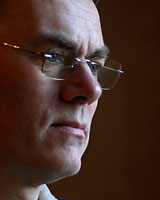Storytelling games
The task. Create an interactive computer based game based on storytelling.
Thom Gillespie passed out index cards and asked everyone to submit one idea for a game. It's that moment your mind goes blank .... and then the competitive spirit kicks in and the process itself becomes a game you want to win even though we didn't know the rules at this stage.
The game of consequences appears to be unknown outside of Britain. Briefly it's a story writing game where each participant writes a paragraph under a defined heading, conceals their contribution by folding down the paper and passes their paper to the next player who adds their contribution under the next heading. The headings are simple e.g. The names of the characters, the place they met, what they said to each other etc. At the end of the game the stories are read out. They are often accidentally amusing.
Inspired by the earlier presentation on dreams and the collision of memories producing surprising and intriguing stories I built the interactive consequences game on two random elements - the players providing a third. The first; headings would be selected from a database, alongside images drawn at random from the internet would provide a context or subject for the paragraph. Once written an email is sent to the next player to continue the story. After it had been passed on through say ten players the story is forwarded to each of them . This provides the basis for each to write a new story. A system of judging/scoring determines the best one and hence the winner.
We were split into groups and handed a pack of ideas. Choose the best and decide how it would be developed. We chose one called Reconstruction. Players are allocated an historic site. Their task; to rebuild the history of the site; creating buildings, characters and scenarios aiming to recreate the society that occupied the site generations before. It is also a game of survival. The clock ticks; time progresses and the inhabitants have to survive against the odds. Scores are incremented for success. a high score board is created.
Coincidentally there was another English woman in my group who had based her idea on Consequences.
Next Thom asked each group to present their game idea to the room. Further ideas were added and suggestions made for funding and marketing.
A stimulating session opening a new door on storytelling - the competition. And the competitive side of game playing appeared to be VERY important for the American delegates. This despite the non competitive style of their digital storytelling - where the process is more important than the product.

